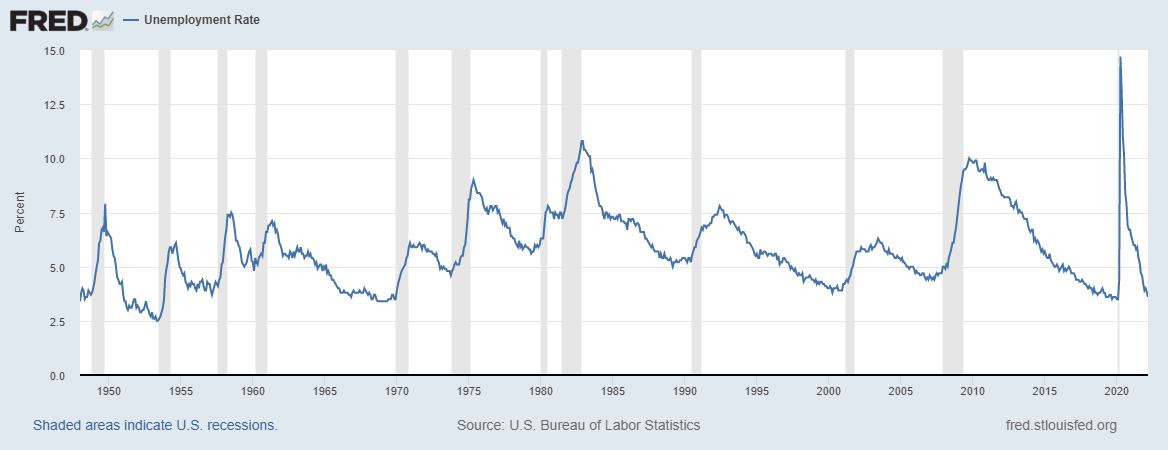How low is unemployment today at 3.6%?
Neil, my concern is that we may end up talking ourselves into a recession. On the other hand, if we observe what people pay and not what they say, the demand side of the equation doesn't seem to be falling.
------------------------------
John Tyson
CFO;Chief Financial Officer
Altamaha Bank & Trust Company
Vidalia, GA
------------------------------
-------------------------------------------
Original Message:
Sent: 04-02-2022 09:17
From: Neil Stanley
Subject: How low is unemployment today at 3.6%?
Using Federal Reserve data since 1948, we discover that the lowest level of unemployment in the last 74 years in the U.S. was 2.5% in 1953. The lowest level so far this century was 3.5% in September 2019 and the first two months of 2020. Therefore, we are only slightly above this record for the century. Today's unemployment at 3.6% is lower than 93.8% of the 890 other monthly reports. Only 6.2% of the time has unemployment been lower than today. We should be aware of all the progress in unemployment we have made since the depths of the pandemic!
https://fred.stlouisfed.org/series/UNRATE

Of course, the ultimate economic issue with respect to employment is the country's productivity in terms of producing valuable goods and services. The unemployment rate shows unemployed as a percentage of the labor force. The participation rate is the percentage of the population that makes up the labor force whether working or actively looking for work. So, both parameters are important as each helps measure the amount of "slack" resources currently on the economic sidelines. Recently both measures have been showing fewer slack resources. Here is a link to the participation rate https://fred.stlouisfed.org/series/CIVPART
.png)
Keep in mind that traditional recessions begin when unemployment is low and the economy has built up surplus inventories. When demand does not keep up with the growing supply the economy goes into a slow-down. The time to be concerned about recession has typically been when supplies become excessive compared to demand. This situation doesn't sound much like today's circumstances to me.
I hope to keep this in mind anytime someone suggests that a severe recession may be just ahead. Economics has so much to do with what the population anticipates. We have the resources, infrastructure, and population for a robust economy. I hope we don't let dramatic headlines from attention seekers distract us. What do you think?
------------------------------
Neil Stanley
------------------------------
------------------------------
John Tyson
CFO;Chief Financial Officer
Altamaha Bank & Trust Company
Vidalia, GA
------------------------------
-------------------------------------------
Original Message:
Sent: 04-02-2022 09:17
From: Neil Stanley
Subject: How low is unemployment today at 3.6%?
Using Federal Reserve data since 1948, we discover that the lowest level of unemployment in the last 74 years in the U.S. was 2.5% in 1953. The lowest level so far this century was 3.5% in September 2019 and the first two months of 2020. Therefore, we are only slightly above this record for the century. Today's unemployment at 3.6% is lower than 93.8% of the 890 other monthly reports. Only 6.2% of the time has unemployment been lower than today. We should be aware of all the progress in unemployment we have made since the depths of the pandemic!
https://fred.stlouisfed.org/series/UNRATE

Of course, the ultimate economic issue with respect to employment is the country's productivity in terms of producing valuable goods and services. The unemployment rate shows unemployed as a percentage of the labor force. The participation rate is the percentage of the population that makes up the labor force whether working or actively looking for work. So, both parameters are important as each helps measure the amount of "slack" resources currently on the economic sidelines. Recently both measures have been showing fewer slack resources. Here is a link to the participation rate https://fred.stlouisfed.org/series/CIVPART
.png)
Keep in mind that traditional recessions begin when unemployment is low and the economy has built up surplus inventories. When demand does not keep up with the growing supply the economy goes into a slow-down. The time to be concerned about recession has typically been when supplies become excessive compared to demand. This situation doesn't sound much like today's circumstances to me.
I hope to keep this in mind anytime someone suggests that a severe recession may be just ahead. Economics has so much to do with what the population anticipates. We have the resources, infrastructure, and population for a robust economy. I hope we don't let dramatic headlines from attention seekers distract us. What do you think?
------------------------------
Neil Stanley
------------------------------
0 Comments
Join the Conversation! 🗣️✨
Be part of our community—sign up now to share your thoughts, connect with others, and stay in the loop!

